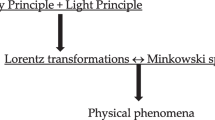Summary
The Daneri-Loinger-Prosperi theory may be regarded as a completion of the programme of Ludwig and Jordan, which is an attempt to prove that quantum mechanics can «stand on its own feet»,i.e. that the measurement problem disappears with the development of a quantum ergodic theory of macrosystems (which in principle replaces classical mechanics as the fundamental theory of the macrolevel). It is argued that the D-L-P theory can not resolve the measurement problem independently of the Copenhagen interpretation. Since the Copenhagen interpretation is presented as a complete solution to the measurement problem in the first place, the quantum theory of macrosystems is irrelevant to this problem.
Riassunto
Si può considerare la teoria di Daneri-Loinger-Prosperi come un completamento del programma di Ludwig e Jordan, che è un tentativo di provare che la meccanica quantistica può «stare in piedi da sola»; e cioè che il problema della misura scompare con lo sviluppo di una teoria ergodica quantistica dei macrosistemi (che in linea di principio rimpiazza la meccanica classica come la teoria fondamentale del macrolivello). Si deduce che la teoria di D-L-P non può risolvere il problema della misura senza tenere conto della interpretazione di Copenhagen. Poichè si presenta in primo luogo l’interpretazione di Copenhagen come una soluzione completa del problema della misura, la teoria quantistica dei macrosistemi non è di fondamentale importanza per questo problema.
Реэюме
Теория Данери-Лоингера-П роспери может быть рассмотрена как эаверщение программы Людвига и ?ордана, которая представляет попытку докаэать, что квантовая механика может « стоять на собственных ногах », т. е. что проблема иэмерения исчеэает с раэвитием квантовой зргодической теории макросистем (которая, в принципе, эаменяет классическую механику как фундаментальную теорию макроуровня). Покаэывается, что теория Д.-Л.-П. не может раэрещить проблему иэмерения неэависимо от Копенгагенской интерпретации. Так как Копенгагенская интерпретация представляется как полное рещение проблемы иэмерения, то квантовая теория макросистем не имеет отнощения к зтой проблеме.
Similar content being viewed by others
References
D. Bohm andJ. Bub:Rev. Mod. Phys.,38, 453 (1966). This article lists some references.
G. Ludwig: Article inWerner Heisenberg und die Physik Unserer Zeit (Braunschweig, 1961).
P. Jordan:Philosophy of Science,16, 269 (1949).
H. S. Green:Nuovo Cimento,9, 880 (1958).
P. K. Feyerabend: Article inObservation and Interpretation; A Symposium of Philosophers and Physicists (London, 1957). (Proceedings of the Ninth Symposium of the Colston Research Society (Bristol, 1957).)
A. Daneri, A. Loinger andG. M. Prosperi:Nucl. Phys.,33, 297 (1962). This article will be referred to as «D-L-P (1)».
A. Daneri, A. Loinger andG. M. Prosperi:Nuovo Cimento,44, 119, (1966).
A. Daneri, A. Loinger andG. M. Prosperi:Nuovo Cimento,44, 127 (1966).
L. Rosenfeld:Suppl. Progr. Theor. Phys., Commemorative Issue for the XXX Anniversary of the Meson theory by Dr.H. Yukawa (1965), p. 222.
N. Bohr:Quantum Physics and Philosophy. Causality and Complementarity; first essay inEssays 1958–1962on Atomic Physics and Human Knowledge (London, 1963), p. 2, 4. ApparentlyN. Bohr regarded this essay as an especially clear and concise expression of his own views on the interpretation of the quantum theory (see the Preface byA. Bohr). All passages quoted fromBohr are exclusively from this source
N. Bohr:Quantum Physics and Philosophy. Causality and Complementarity; first essay inEssays 1958–1962 on Atomic Physics and Human Knowledge (London, 1963), p. 3.
N. Bohr:Quantum Physics and Philosophy. Causality and Complementarity; first essay inEssays 1958–1962 on Atomic Physics and Human Knowledge (London, 1963), p. 3.
N. Bohr:Quantum Physics and Philosophy. Causality and Complementarity; first essay inEssays 1958–1962 on Atomic Physics and Human Knowledge (London, 1963), p. 3.
N. Bohr:Quantum Physics and Philosophy. Causality and Complementarity; first essay inEssays 1958–1962 on Atomic Physics and Human Knowledge (London, 1963), p. 3, 4.
N. Bohr:Quantum Physics and Philosophy. Causality and Complementarity; first essay inEssays 1958–1962 on Atomic Physics and Human Knowledge (London, 1963), p. 4.
Of course, this follows only if all Bohr’s assumptions are accepted as true. The hidden variable approach to the measurement problem rejects the thesis that unambiguous information about what is observed is necessarily described in terms of classical concepts, and develops the thesis that macroscopic measuring instruments and microscopic measured systems are on different levels of functioning which are not related mechanically. This leads to a new theory with new experimental consequences, in which the hidden variables are related to theorder of results in suitable sequences of measurements. SeeD. Bohm andJ. Bub:op. cit., andJ. Bub:Hidden variables and the Copenhagen interpretation. A reconciliation, to be published inBritish Journ. Phil. Sci.
D-P-L (1), p. 298.
L. Rosenfeld:Suppl. Progr. Theor. Phys., Commemorative Issue for the XXX Anniversary of the Meson Theory by Dr.H. Yukawa (1965), p. 230.
D-L-P (1), p. 298.
D-L-P (1), p. 315.
For a comparison between the concept of «macrovariable» in classical and quantum mechanics, see for exampleN. G. van Kampen:Fundamental problems in statistical mechanics of irreversible process. Article inFundamental Problems in Statistical Mechanics, Proceedings of the NUFFIC International Summer Course in Science at Nijenrode Castle, The Netherlands, August 1961. Compiled byE. G. D. Cohen (Amsterdam, 1962).
D-L-P (1), p. 298.
D-L-P (1), p. 309.
D-L-P (1), p. 310.
D-L-P (1), p. 310, 311. See also remarks before eq. (10.3).
D-L-P (1), p. 311. Remarks after eq. (9.8).
D-L-P (1), p. 311. Remarks before eq. (9.8′).
Author information
Authors and Affiliations
Additional information
Correspondence with Prof.D. Bohm, of Birkbeck College, London University, and with Prof.A. Loinger, of the Università di Pavia, has been of considerable help in clarifying the ideas of this article.
Rights and permissions
About this article
Cite this article
Bub, J. The Daneri-Loinger-Prosperi quantum theory of measurement. Nuovo Cimento B (1965-1970) 57, 503–520 (1968). https://doi.org/10.1007/BF02710216
Received:
Published:
Issue Date:
DOI: https://doi.org/10.1007/BF02710216




